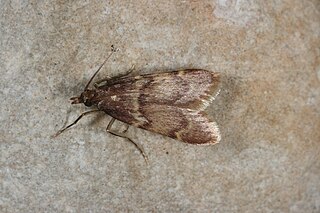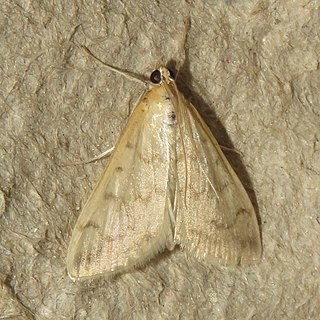Hydropionea is a genus of moths of the family Crambidae. The 13 described species are distributed in Central and South America.
Idia immaculalis, the immaculate idia, is a litter moth of the family Erebidae. The species was first described by George Duryea Hulst in 1886. It is found in North America from at least California, north and east across Montana to southern Alberta and Saskatchewan.

Acallis gripalis is a species of snout moth in the genus Acallis. It was described by George Duryea Hulst in 1886. It is found in North America, including Colorado, British Columbia, California and Arizona.
Cactobrosis fernaldialis, the blue cactus borer, is a species of snout moth in the genus Cactobrosis. It was described by George Duryea Hulst in 1886, and is found from Texas to southern California, where it inhabits deserts.

Synchlora xysteraria is a moth of the family Geometridae first described by George Duryea Hulst in 1886. It is found in the US states of Georgia and Florida and on Cuba and Hispaniola.

Elophila gyralis, the waterlily borer moth, is a moth in the family Crambidae. It was described by George Duryea Hulst in 1886. It is found in eastern North America, where it has been recorded from Alabama, Florida, Georgia, Illinois, Indiana, Iowa, Louisiana, Maine, Maryland, Massachusetts, Michigan, Minnesota, Mississippi, New Brunswick, New Hampshire, New Jersey, New York, North Carolina, Nova Scotia, Ohio, Oklahoma, Ontario, Pennsylvania, Quebec, South Carolina, Tennessee, Texas and Wisconsin.
Agriphila biothanatalis is a moth in the family Crambidae. It was described by George Duryea Hulst in 1886. It is found in North America, where it has been recorded from California and Oregon.
Crambus trichusalis is a moth in the family Crambidae. It was described by George Duryea Hulst in 1886. It is found in North America, where it has been recorded from Alberta, Saskatchewan, Montana, North Dakota and South Dakota. The habitat consists of grasslands.
Prionapteryx cuneolalis is a moth in the family Crambidae. It was described by George Duryea Hulst in 1886. It is found in North America, where it has been recorded from Texas.
Abegesta reluctalis is a moth in the family Crambidae. It was described by George Duryea Hulst in 1886. It is found in North America, where it has been recorded from Arizona, California, Maryland and New Mexico.
Anania labeculalis is a moth in the family Crambidae. It was described by George Duryea Hulst in 1886. It is found in North America, where it has been recorded from Arizona to western Texas.

Hahncappsia pergilvalis is a moth in the family Crambidae. It was described by George Duryea Hulst in 1886. It is found in North America, where it has been recorded from Ontario and the north-eastern and south-western United States. It is also present in Mexico, where it has been recorded from the Federal District, Puebla and Jalisco.

Loxostege lepidalis is a moth in the family Crambidae. It was described by George Duryea Hulst in 1886. It is found in North America, where it has been recorded from Alberta and eastern Washington to California and New Mexico.
Loxostege thrallophilalis is a moth in the family Crambidae. It was described by George Duryea Hulst in 1886. It is found in North America, where it has been recorded from southern British Columbia to northern California, as well as from Montana.

Pyrausta nexalis, the fulvous-edged pyrausta moth, is a moth in the family Crambidae. It was described by George Duryea Hulst in 1886. It is found in North America, where it has been recorded from Washington, Montana, Arizona, California, New Mexico, Oklahoma, Texas and Utah.
Saucrobotys fumoferalis, the dusky saucrobotys moth, is a moth in the family Crambidae. It was described by George Duryea Hulst in 1886. It is found in North America, where it has been recorded from Nova Scotia west to British Columbia, north to Yukon, and south to Pennsylvania, Illinois and California. The habitat consists of boreal forests, mixed forests and woodlots.

Chloropteryx tepperaria, the angle-winged emerald moth, is a moth of the family Geometridae. The species was first described by George Duryea Hulst in 1886 and it is found in the southeastern United States.
Noctueliopsis bububattalis is a moth in the family Crambidae. It was described by George Duryea Hulst in 1886. It is found in North America, where it has been recorded from Arizona, California, Colorado, New Mexico, Texas and Utah.
Choristostigma roseopennalis is a moth in the family Crambidae. It was described by George Duryea Hulst in 1886. It is found in Mexico and the United States, where it has been recorded from Arizona, Georgia, Indiana, Maryland, North Carolina, Ohio, Tennessee and Texas.
Udea octosignalis is a moth in the family Crambidae. It was described by George Duryea Hulst in 1886. It is found in North America, where it has been recorded from California and Texas.






